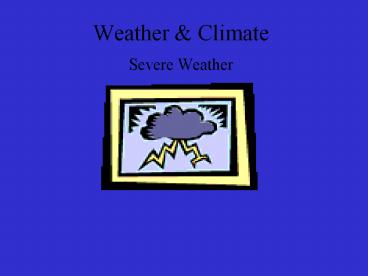Weather - PowerPoint PPT Presentation
1 / 44
Title: Weather
1
Weather Climate
- Severe Weather
2
Objectives
- List and describe the main types of storms and
explain how they form. - List and describe basic safety for severe weather
situations.
3
STORMS
- A storm is a violent disturbance in the
atmosphere. - They involve sudden changes in air pressure.
- Changes in air pressure causes rapid air movement.
4
Thunderstorms
Formation W/in large cumulonimbus, or thunderheads Form when warm air is forced upward at a cold front Temperature Hot, humid afternoons in the spring and summer Precipitation Heavy rainfall Sometimes hail Safety Avoid touching metal objects Install metal lightening rods Find a low area away from trees Stay away from water
5
Thunderstorms
- During a thunderstorm, positive and negative
electrical charges build up in the clouds. - The discharge of the electricity between clouds
is lightening. - Lightening is as hot as 30,000C, hotter than the
sun. - The heated air expands and explodes producing
thunder.
6
(No Transcript)
7
(No Transcript)
8
(No Transcript)
9
(No Transcript)
10
(No Transcript)
11
Tornado
- Rapidly whirling, funneled-shaped cloud that
reaches down from a storm cloud to touch Earths
surface - Most frightening disruptive storm
- Usually brief, touching the ground approx. 15
minutes or less - Wind speeds may reach 480 km/hr
12
Tornado
Formation Develop in low, heavy cumulonimbus clouds When warm dry air mass and cool air mass collide Temperature Warm humid air Spring and early summer when ground is warm Precipitation Heavy rain and wind Safety Listen for watches warnings Basement level, or to the middle room on ground floor Stay away from windows Lie in a ditch
13
Tornado
- Tornado Watch tornadoes are possibly in your
area - Tornado Warning tornadoes have been seen in the
sky or on weather radar - Occur most often in the US
- Approx. 800 tornadoes a year
14
Checkpoint
- Where do tornadoes form?
- Why is there a tornado alley?
- What states make up tornado alley?
- Low heavy cumulonimbus clouds
- Warm humid air mass moves north from Gulf of
Mexico and meets a cold dry mass that is moving
south from Canada - SD, Iowa, Nebraska, Kansas, Missouri, Oklahoma,
TX, NM, and Arkansas
15
(No Transcript)
16
(No Transcript)
17
(No Transcript)
18
(No Transcript)
19
(No Transcript)
20
(No Transcript)
21
(No Transcript)
22
(No Transcript)
23
(No Transcript)
24
Hurricanes
- Tropical storm that has winds of 119 km/hr
- Usually occur between June and November in the
eastern US
25
Hurricanes
Formation Begins over warm water as a low pressure area, tropical disturbance Gets it energy from warm humid air at the oceans surface Temperature Warm temperatures Precipitation Strong winds Rain which generally causes flooding Safety Evacuate Move into the interior room and stay away from windows
26
Hurricanes
- Occur between June and November
- Effect people that live on the coast of the
Atlantic, Pacific, and Indian Oceans - Eye center of a hurricane
27
(No Transcript)
28
(No Transcript)
29
(No Transcript)
30
(No Transcript)
31
(No Transcript)
32
(No Transcript)
33
Winter Storms
- Lake-effect Snow In the fall and winter, land
cools faster than the lakes. - When cool air mass moves from Canada across Great
Lakes it picks up water vapor and heat from
lakes. - After the air mass
- passes the lakes it begins
- to cool and the water vapor
- condenses and falls as snow
34
What is it?
- A Blizzard is a blinding snowstorm with very
strong winds and cold temperatures
35
When do they take place?
- Blizzards are storms that happen in the winter
months.
36
How do they occur?
- Blizzards occur when a warm air mass runs into a
cold air mass. Clouds form and the cold air
freezes the moisture in the warm air mass. The
wind speeds increase and snow falls to the
ground.
37
Where do they take place?
38
Safety Precautions
- Find shelter indoors.
- 2. Stay away from windows and doors.
- 3. If you are stuck in a car with the engine
running to stay warm, keep the windows open a
little bit. This will let poisonous carbon
monoxide escape from the inside of the car. - 4. Keep extra food and water, flashlight, a
battery-operated radio, and, if possible, a cell
phone with you. - 5. If you are trudging through deep snow, keep
moving. Do not lie down to rest. - 6. If you are caught outdoors, use clothing to
cover your face and as much of your skin as you
can.
39
(No Transcript)
40
(No Transcript)
41
(No Transcript)
42
(No Transcript)
43
(No Transcript)
44
Your Assignments
- You will work in predetermined groups.
- Within your group, you will create a skit
demonstrating your knowledge on severe weather
safety. - What is your severe weather?
- How does it occur?
- What are the safety precautions you should take
if you are inside/outside? - 1. group leaders (directors)
- 2. researchers (computer)
- 3. recorders (write everything down)































